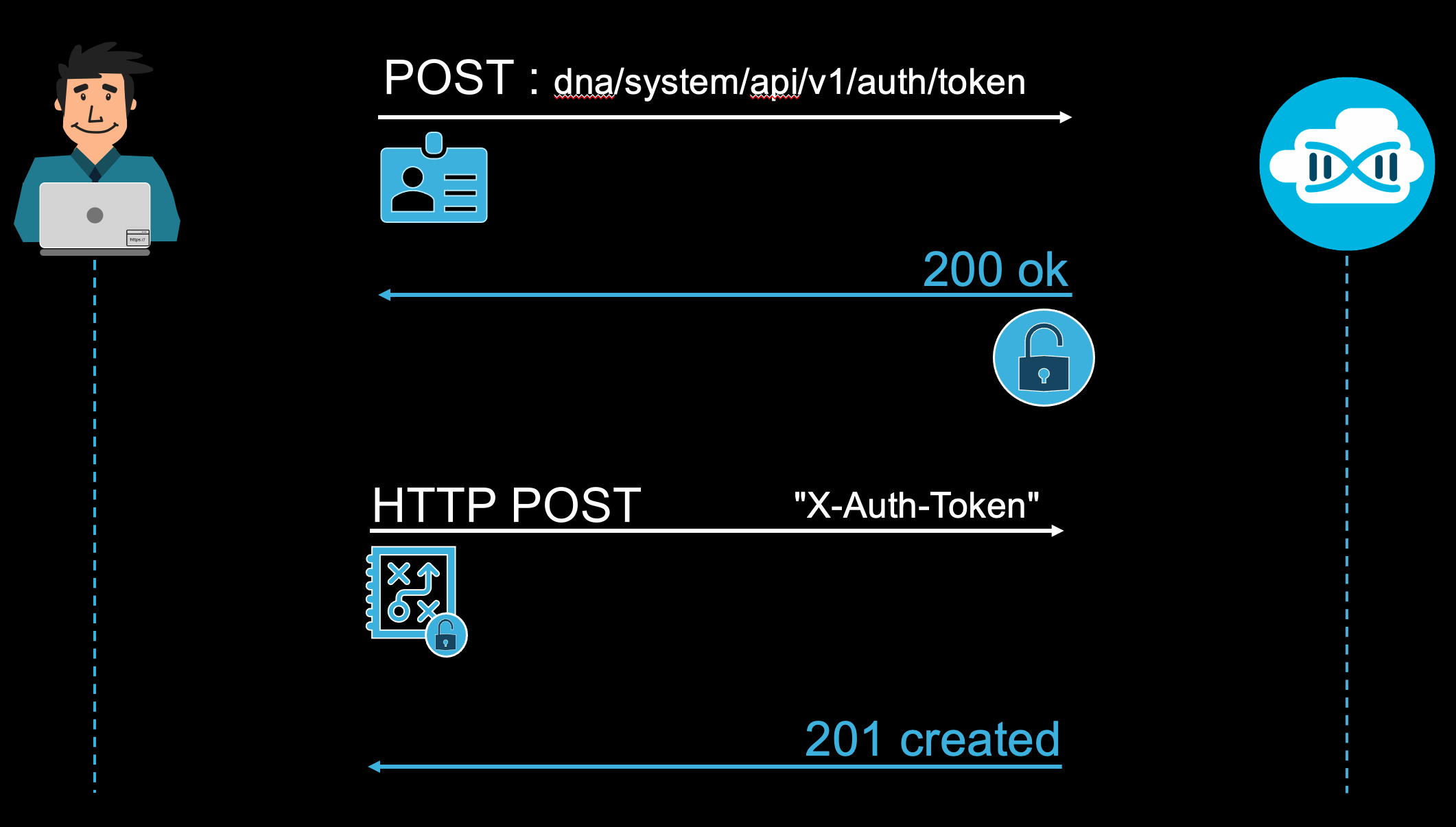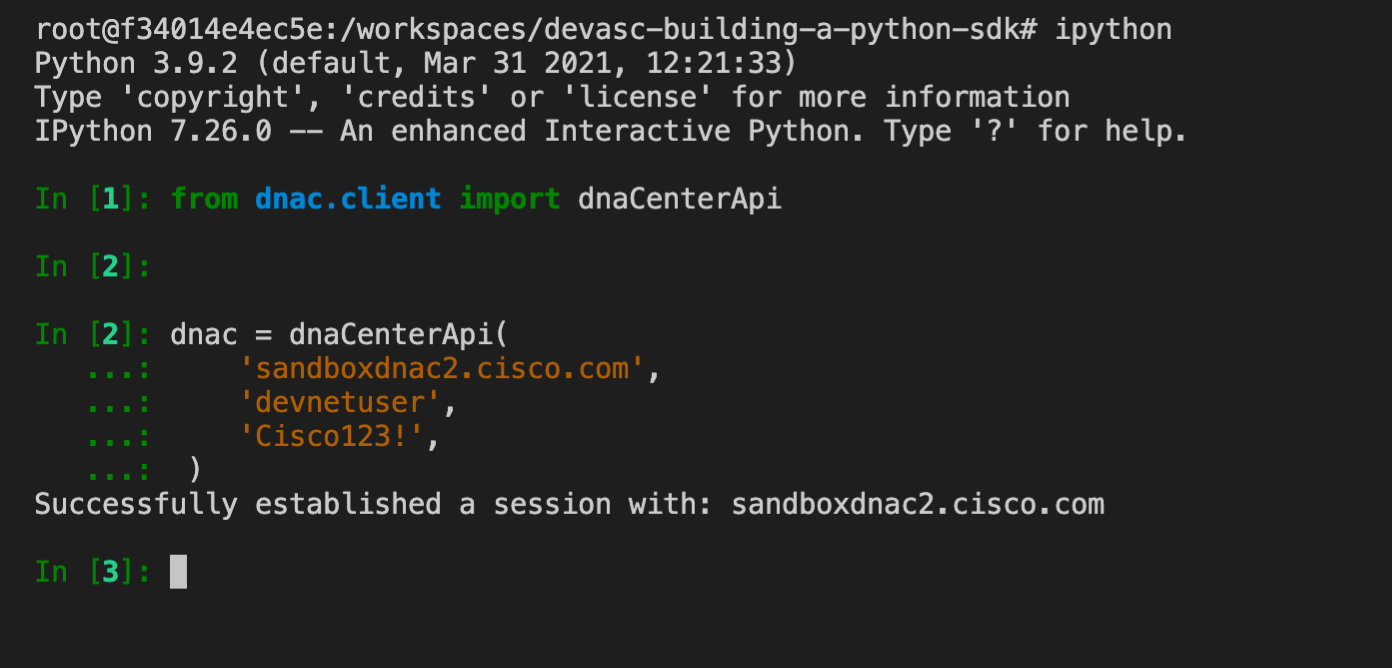Create a Python Module: client
![]()
The job of the client module is to wrap the REST endpoints available on the platform and serve as the interface to the consumer. This section will build the API wrapper module using a combination of resources as a reference.
The client is the Python object that is the external interface for the SDK. A consumer of this SDK would instantiate an instance of the client where all of the necessary methods would exist for interacting with the target system, DNA Center.
Create the Module
STEP 1. CREATE a file named client.py in the dnac/ directory (the package)
touch dnac/client.py
Python modules are just files with the .py extension.
STEP 2. OPEN the dnac/client.py file in your editor
STEP 3. import the REST Client you created using relative imports
This is the session module that you created in the last section and it will be referenced here.
from .session import dnaCenterSession
Read More on Relative Imports
Here is a reference for Relative Imports in Python
STEP 4. CREATE a class named dnaCenterApi
Since this is the wrapper class it isn't inheriting from any other existing class (except Object which is implied). This is the main interface to the consumer of our SDK.
class dnaCenterApi:
"""
DNA Center API Wrapper Class
"""
STEP 5. DEFINE a method named __init__
The __init__ constructor determines how an object is instantiated from a class. I this case the __init__ method will create a new dnaCenterSesssion object, set the auth and verify values, then call get_token to obtain a reusable token for all future calls.
def __init__(self,
host: str,
username: str,
password: str,
verify: bool = True
):
"""Initialize the dnaCenterApi class object. dnaCenterAPI
provides an interface to the REST API of Cisco DNA Center
Args:
host (str): IP Address or Fully Qualified Domain Name of the DNA
Center Appliance
username (str): username is used for initial Basic Auth
password (str): password
verify (bool, optional): Certificate verification flag.
Defaults to True.
"""
self.session = dnaCenterSession()
self.host = host
self.base_url = f"https://{host}"
if username and password:
self.session.set_basic_auth(username, password)
self.session.set_verify(verify)
self.get_token()
STEP 6. DEFINE a method named get_token

This is only method that will use Basic Auth. All other methods will utilize the token that is added to the header in this method.
def get_token(self) -> str:
"""Obtain an authentication token for subsequent API calls
Returns:
str: Token string that will be set in the x-auth-token header
of the self.session object
"""
_response = self.session.post(
self._build_url('/dna/system/api/v1/auth/token')
)
if _response.ok:
print(f"Successfully established a session with: {self.host}")
self.session.headers.update(
{
'x-auth-token': _response.json().get('Token')
}
)
STEP 7. DEFINE a method named _build_url
This is a simple example of abstracting code that would need to be repeated in every API endpoint wrapper into its own method.
def _build_url(self, resource: str) -> str:
"""Generate the full URL based on the self.base_url plus the provided
resource (API endpoint)
Args:
resource (str): API Endpoint suffix as found in the API documentation
Returns:
str: Full URL for API call
"""
return self.base_url + resource
STEP 8. DEFINE a method named _make_request
The _make_request_ method is responsible for executing the requests.Session.request method which is associated with the self.session attribute of our client.
def _make_request(self, method: str, url: str, json: dict = None, params: dict = None):
"""Execute the request method of the Session object
Args:
method (str): HTTP Method passed to the session object
[ GET, POST, PUT, PATCH, DELETE ]
url (str): Full URL of the API endpoint
json (dict, optional): Body if required. Defaults to None.
params (dict, optional): [description]. Defaults to None.
Returns:
[type]: [description]
"""
results = self.session.request(method, url, json=json, params=params)
if results.ok:
return results.json()
results.raise_for_status()
STEP 9. SAVE the file
You did it!
Launch iPython and see if your code works.
STEP 10. OPEN a Python Interpreter
STEP 11. PASTE the text below
from dnac.client import dnaCenterApi
dnac = dnaCenterApi(
'sandboxdnac2.cisco.com',
'devnetuser',
'Cisco123!'
)

Add API Wrapper Method to Get Sites
Now that the basic mechanics of your API Client work and you can establish a session with a DNA Center it's time to add some functions to target specific REST Endpoints. The first endpoint that will be added is the site endpoint.
The get_sites method of our dnaCenterApi client targets the /dna/intent/api/v1/site endpoint and takes a single parameter named params. Since this is specifically wrapping a GET request, the params parameter allows you to pass a dictionary of key/value pairs that will serve as the query parameters for that call. See the DNA Center API for more details on fields available.
def get_sites(self, params: dict = None) -> dict:
"""Retrieve the sites from DNA Center
Args:
params (dict, optional): query parameters to filter the results.
Defaults to None.
Returns:
dict: dictionary of the response from DNA Center
"""
resource = "/dna/intent/api/v1/site"
return self._make_request(
'GET',
self._build_url(resource),
params=params
)
Add API Wrapper Method to Get Network Devices
def get_network_devices(self, params: dict = None) -> dict:
"""Retrieves network devices from DNA Center
Args:
params (dict, optional): query parameters to filter the results.
Defaults to None.
Returns:
dict: Network Devices
"""
resource = "/dna/intent/api/v1/network-device"
return self._make_request(
'GET',
self._build_url(resource),
params=params
)
Save Your Work!
Don't forget to your work!
Full File
This is what the full file will look like for comparison. You can also copy this and paste it over the contents you have created to be sure.
#!/usr/bin/env python
from .session import dnaCenterSession
class dnaCenterApi:
"""
DNA Center API Wrapper Class
"""
def __init__(self,
host: str,
username: str,
password: str,
verify: bool = True
):
"""Initialize the dnaCenterApi class object. dnaCenterAPI
provides an interface to the REST API of Cisco DNA Center
Args:
host (str): IP Address or Fully Qualified Domain Name of the DNA
Center Appliance
username (str): username is used for initial Basic Auth
password (str): password
verify (bool, optional): Certificate verification flag.
Defaults to True.
"""
self.session = dnaCenterSession()
self.host = host
self.base_url = f"https://{host}"
if username and password:
self.session.set_basic_auth(username, password)
self.session.set_verify(verify)
self.get_token()
def get_token(self) -> str:
"""Obtain an authentication token for subsequent API calls
Returns:
str: Token string that will be set in the x-auth-token header
of the self.session object
"""
_response = self.session.post(
self._build_url('/dna/system/api/v1/auth/token')
)
if _response.ok:
print(f"Successfully established a session with: {self.host}")
self.session.headers.update(
{
'x-auth-token': _response.json().get('Token')
}
)
def _build_url(self, resource: str) -> str:
"""Generate the full URL based on the self.base_url plus the provided
resource (API endpoint)
Args:
resource (str): API Endpoint suffix as found in the API documentation
Returns:
str: Full URL for API call
"""
return self.base_url + resource
def _make_request(self, method: str, url: str, json: dict = None, params: dict = None):
"""Execute the request method of the Session object
Args:
method (str): HTTP Method passed to the session object
[ GET, POST, PUT, PATCH, DELETE ]
url (str): Full URL of the API endpoint
json (dict, optional): Body if required. Defaults to None.
params (dict, optional): [description]. Defaults to None.
Returns:
[type]: [description]
"""
results = self.session.request(method, url, json=json, params=params)
if results.ok:
return results.json()
results.raise_for_status()
# API Endpoints
def get_sites(self, params: dict = None) -> dict:
"""Retrieve the sites from DNA Center
Args:
params (dict, optional): query parameters to filter the results.
Defaults to None.
Returns:
dict: dictionary of the response from DNA Center
"""
resource = "/dna/intent/api/v1/site"
return self._make_request(
'GET',
self._build_url(resource),
params=params
)
def get_network_devices(self, params: dict = None) -> dict:
"""Retrieves network devices from DNA Center
Args:
params (dict, optional): query parameters to filter the results.
Defaults to None.
Returns:
dict: Network Devices
"""
resource = "/dna/intent/api/v1/network-device"
return self._make_request(
'GET',
self._build_url(resource),
params=params
)
Section Wrap up
You now have a functional Python package that includes a session object and a client object. This package allows you to establish a connection/session with Cisco DNA Center and retrieve the sites and/or network devices using API methods you wrote to wrap the API endpoints.
In the next section you will write a simple Python script that uses this package. The point of write a package to reduce the amount of code you have to write on subsequent tasks with the same logic.